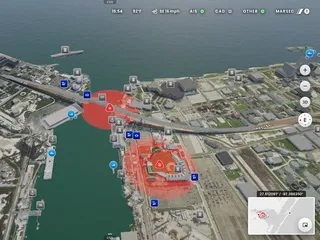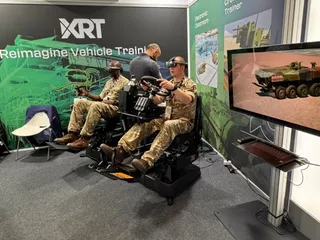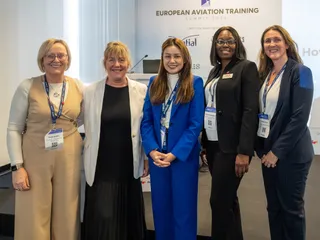An Active Digital Twin Leading the Way
Contact Our Team
For more information about how Halldale can add value to your marketing and promotional campaigns or to discuss event exhibitor and sponsorship opportunities, contact our team to find out more
The Americas -
holly.foster@halldale.com
Rest of World -
jeremy@halldale.com

Digital twins are increasingly everywhere as one follows our three editorial verticals in military, civil aviation and safety critical industries, and for our live events.
A use case for digital twin and its underlying data foundation that caught the author’s attention during routine research on technology developments was the Port of Corpus Christi’s (Texas) requirements to integrate disparate data and content streams into a unified platform to provide stakeholders with one operational picture and supply resilience during routine operations and crisis response. Enter OPTICS (Overall Port Tactical Information System), an active digital twin developed by The Acceleration Agency in collaboration with the Port.
Beyond active digital twin, this article highlights: the importance of industry collaboration in a large-scale simulation project; the opportunity to gain early ROIs from a successfully implemented and managed simulation-based contract; and the melding of technologies into a successful product.
Supporting the Maritime Operating Environment
The Port of Corpus Christi is one of the largest US energy ports, managing complex flows of crude oil, refined products, LNG, bulk cargo and other commodities. Its infrastructure includes more than 20 terminals, multiple channels, and critical connections to rail and highway systems.
Starr Long, Executive Producer at The Acceleration Agency, recalled the Port faced the challenge of coordinating across diverse operational silos: vessel traffic, energy exports, emergency management, security, and community stakeholders. “Data was fragmented across legacy systems, stand-alone dashboards, and manual processes. Critical stakeholders included the port’s IT and administration, the police department, and the harbormaster. Leadership required a unified platform that could integrate these streams into one operational picture and provide resilience during both routine operations and crisis response.”
Partnering and Integrating Technologies
Answering the Port’s requirements’ call was OPTICS, the active digital twin developed by The Acceleration Agency and built on the company’s ProjectGemini Digital Twin platform and framework. The industry executive initially explained OPTICS fuses geospatial data, IoT [internet of things] sensor feeds, vessel tracking, weather inputs, and emergency dispatch systems into a real-time, navigable 3-D model of the Port. “The system integrates ArcGIS (via Esri), 3-D rendering (via Unity), and a secure platform to connect with partner systems. Rather than another 2-D dashboard, OPTICS creates an intuitive ‘single pane of glass’ where port operators, security personnel, and first responders can see assets, anticipate risks, and coordinate decisions.”
Of note, OPTICS was fielded in roughly nine months from contract to operational use. Long recalled operator training “was fast because the interface was designed to mirror natural spatial awareness — more like a flight simulator than a database.” Teams trained in weeks rather than months, with emergency exercises used as both training and validation. The executive emphasized that TAA and the Port’s stakeholders collaborated continuously during build-out: iterative workshops clarified requirements, prioritized integrations, and tested scenarios. This reduced downstream rework and ensured buy-in across multiple agencies and departments.
Long explained two factors produced this speed:
- Framework leverage: The Acceleration Agency built OPTICS on ProjectGemini, its reusable active digital twin foundation; and
- Ecosystem partnership: The Acceleration Agency led a team including Esri for GIS, Unity for 3D visualization and simulation, and specialized providers for weather and sensor feeds.
Early ROIs
TAA provided four early ROIs from the Port of Corpus Christi’s investment in OPTICS:
- Emergency response drills that once required manual coordination now unfold in real time within OPTICS, reducing planning and exercise time;
- Ship movement visibility has improved, reducing bottlenecks and improving safety in one of the busiest US energy export corridors;
- Stakeholder confidence: operators, local emergency agencies, and federal partners now share a single source of truth, improving decision speed and credibility; and
- While precise dollar figures remain proprietary, the Port has emphasized gains in efficiency, resilience, and coordination that translate into reduced downtime, better throughput, and improved safety.
The Primacy of the Active Digital Twin
One important lesson learned from the delivery of OPTICS to Port of Corpus Christi was the choice of an active digital twin as the core technology. “This was deliberate,” Long emphasized, and added, while many “smart port” efforts stop at data dashboards, the Port of Corpus Christi wanted an operational system where data is spatially accurate, real-time, and immediately usable by operators. “This principle guided every technical decision.”
The TAA executive offered other lessons learned from this contract work of interest to the broader simulation and training community:
- Scope discipline: Ambition exceeded budget early on. The team had to prioritize the highest-value use cases first, then sequence additional features;
- Integration reality: Partner systems varied in maturity. Some had modern APIs; others had no external interface. TAA had to create a “swagger document” to design an endpoint for one partner, then co-implement with them while maintaining CJIS [Criminal Justice Information Services]-compliant data security;
- Stakeholder management: Multiple agencies had different needs and vocabularies. Facilitated workshops proved essential to aligning language, requirements, and trust;
- Iterative delivery: Showing results early (rather than waiting for a big-bang launch) built momentum and credibility; and
- For other ports, cities, or bases considering digital twins, the takeaway is: start with a focused but expandable foundation, integrate steadily, and use live exercises as both training and validation.
[Author’s note: An OPTICS operational scenario may be viewed here. Source: The Acceleration Agency.]


